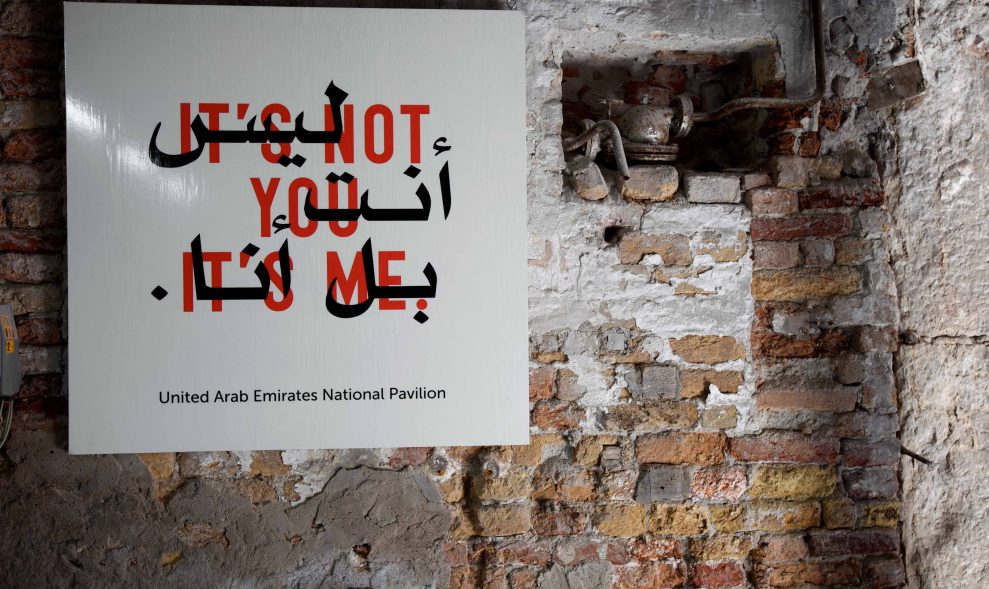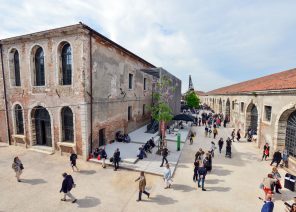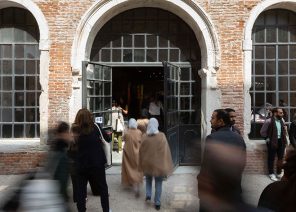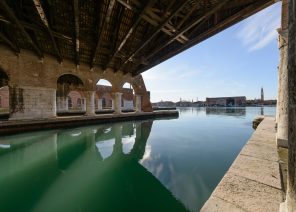2009
National Pavilion UAE Announces Exhibition Title – Its Not You Its Me

United Arab Emirates, March 15, 2009
Raising awareness that the United Arab Emirates is emerging as an important contributor to the world of contemporary art, the UAE Pavilion will welcome visitors from June 7 through November 22, 2009, as the nation’s oficial contribution to the Venice Biennale. Having announced their participation in Venice in November 2008, the project’s organisers have now revealed details of the artistic programme for this initiative, the first national pavilion ever to be created at the Biennale by an Arabian Gulf country.
Established in 1895, the Venice Biennale today encompasses the official pavilions of more than 70 nations. Its International Art Exhibition draws more than 300,000 influential visitors from around the world.
The UAE Pavilion has been initiated and supported by His Excellency Abdul Rahman Mohammed Al Owais, UAE Minister of Culture, Youth and Community Development, the Emirates Foundation and Dubai Culture and Arts Authority. The UAE Pavilion is being developed and presented under the leadership of its Commissioner, Dr. Lamees Hamdan, a member of the Board of Directors of the Dubai Culture and Arts Authority. Serving as curator for the UAE Pavilion is Tirdad Zolghadr, an internationally respected curator, critic, professor and filmmaker.
“It’s Not You, It’s Me”
The UAE Pavilion will be titled “It’s Not You, It’s Me,” a playful and provocative name for the country’s first pavilion at the world’s most prestigious contemporary art event. “By and large, art professionals around the world dismiss the notion that a pavilion can truly represent a nation,” Zolghadr explains. “There still remains much to consider—especially when the nation in question is a place where more efforts are being invested in the development of a global art arena, within a smaller geographic space, and within a shorter time frame, than ever attempted before.”
“Coming from a new arrival at the Venice Biennale,” Zolghadr continues, “the title ‘It’s Not You, It’s Me’ might therefore be interpreted to mean, ‘Look, it’s the UAE’s turn now.’ The UAE Pavilion will be unapologetic about documenting the nation—even while the Pavilion as a whole can be seen as an exhibition about exhibition-making, reflecting on the very act of national showcasing at the Venice Biennale.”
Built in a large and prominent location in the Arsenale—one of the two main areas of the Venice Biennale—the Pavilion will draw attention to its nature and function as a showcase through a combination of scenographic elements and architectural design by the partnership of Rami Farook (founder of the UAE’s Trafic design gallery) and the Belgian architectural collective D’haeseleer & Kimpe & Poelaert, known for its collaborations with visual artists. Physically, the entire Pavilion will highlight a “World Fair” theme that will incorporate various components:
- work by the featured artist, Lamya Gargash
- a documentation of a Dubai performance by the Jackson Pollock Bar
- a Kiosk featuring conversations with key figures in the cultural panorama of the country
- a showroom of work by several UAE artists
- scenography reminiscent of the World Fair tradition, including text panels and architectural models of UAE arts infrastructure
As Zolghadr states, “The UAE Pavilion offers a set of parallel endeavors – artistic, performative, architectural, discursive – which enjoy a measure of independence and singularity within a larger whole.”
The Art and the Artist
For the exhibition in the UAE Pavilion, Lamya Gargash has created a series of photographs titled “Familial”, the series plays on the aesthetics of hospitality, the politics of interior design and the disingenuous lure of documentation,” Zolghadr comments. “Although the work successfully stands on its own and for itself, the connections to the Pavilion as a whole are perceptible, and even tangible.”
Born in Dubai in 1982, Lamya Gargash frequently dwells on themes of identity, culture and the passage of time, as evoked in modes of dress and the design of architectural spaces. Her work has been shown in exhibitions including Dubai Next (organized at the Vitra Museum by Rem Koolhaas and Jack Persekian in conjunction with Art Basel 2008), Abu Dhabi Art, Talk & Sensations (organized by Fabrice Bousteau in conjunction with artparis Abu Dhabi 2008) and the Locarno Film Festival (where she presented her animation, Untitled, in 2006).
Art and the National Pavilion
“If our project is to grapple with the basics of a national pavilion,” Zolghadr states, “then the documentation of a wider art scene is crucial.” The UAE Pavilion will include a selective archive of UAE artists, showcasing Hassan Sharif*, Tarek Al Ghoussein, and Huda Saeed Saif.
Another important feature is a specially commissioned video installation by the Berlin-based artist, dramaturge and curator Hannah Hurtzig. Using a format based on her existing “Kiosk” series, Hurtzig arranged and documented a series of five conversations, held in Abu Dhabi and Dubai in March 2009. For each conversation, a key figure in the development of the cultural scene in the UAE was carefully paired with a partner from either inside or outside the country. Visitors to the UAE Pavilion will be able to listen to the conversations on wireless headsets, selecting from the choices on the Kiosk display.
A further element of the space will be a video documentation of a performance by the theatre troupe Jackson Pollock Bar, which specializes in reconstructing conferences and lectures. Their method is to transcribe and edit a record of an event and then re-create it onstage, lip-synching to a soundtrack. For its performance for the UAE Pavilion, Jackson Pollock Bar worked with actors to re-create the oficial press conference announcing the UAE Pavilion in December 2008 at Art Basel Miami Beach. The video of the performance will be on display within the UAE Pavilion throughout the Biennale.
Finally, the UAE Pavilion will include a scenographic display of elements that are typical of world expositions. It will include architectural models of UAE museum infrastructure: both the existing facilities (such as the Sharjah Art Museum and Sharjah Museum of Islamic Civilization) and those that are being planned (such as the Saadiyat Island Cultural District in Abu Dhabi, which includes the Louvre Abu Dhabi and Guggenheim Abu Dhabi Museum, and the Museum of Middle Eastern Modern Art – MOMEMA). Elegantly obtrusive text panels will amplify the effect of the display.
Executive Committee
A high-level Executive Committee has been formed to advise and support the development of the UAE Pavilion at the Venice Biennale. The Executive Committee is comprised of highly respected individuals who have contributed to contemporary art within the UAE throughout their careers: Zaki Nusseibeh (Chairman), Sheikha Lateefa Bint Maktoum, Sheikha Maisa Al Qassimi, Mubarak Hamad Al Muhairi, Safia Saeed Al Raqbani, Yasser Hareb and Omran Al Owais.
Sponsorship and Support
The UAE Pavilion at the Venice Biennale is initiated by the Ministry of Culture, Youth and Community Development, and is sponsored by the Emirates Foundation and the Dubai Culture and Arts Authority (DCAA).
* Hassan Sharif’s work is being loaned to the UAE National Pavilion for the Venice Biennale from The Arab Museum of Modern Art, Qatar Foundation & Qatar Museums Authority.


